9+ SAMPLE Health And Safety Method Statement
-

Health And Safety Method Statement
download now -
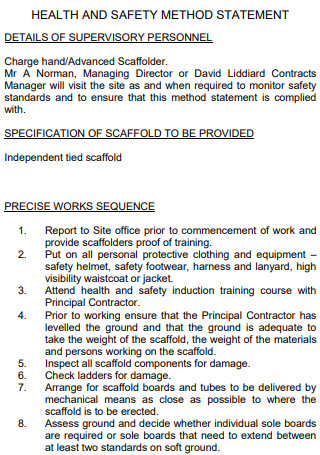
Sample Health And Safety Method Statement
download now -
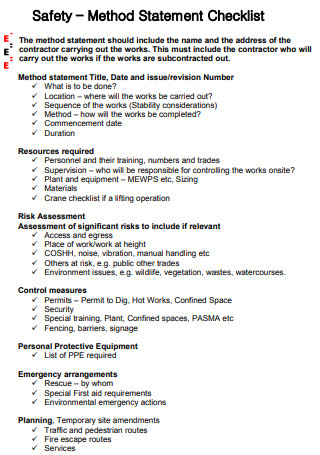
Safety Method Statement Checklist
download now -
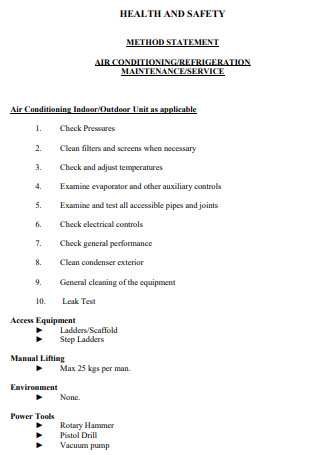
Formal Health And Safety Method Statement
download now -
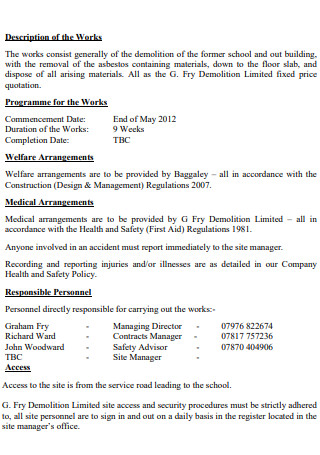
Safety Method Statement for School
download now -
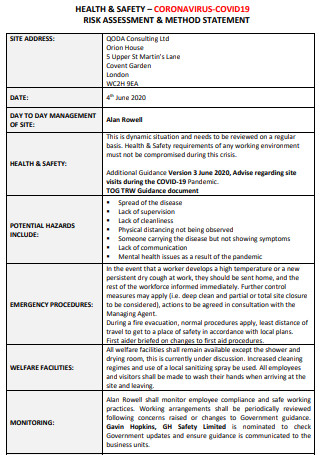
Health And Safety Coronavirus Risk Assessment Method Statement
download now -
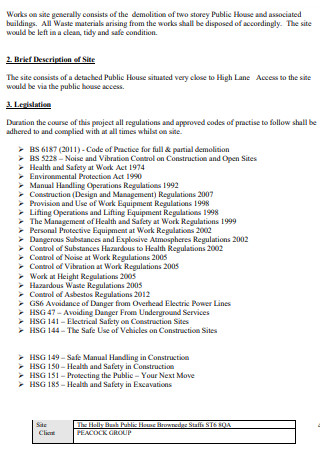
Sample Safety Method Statement
download now -
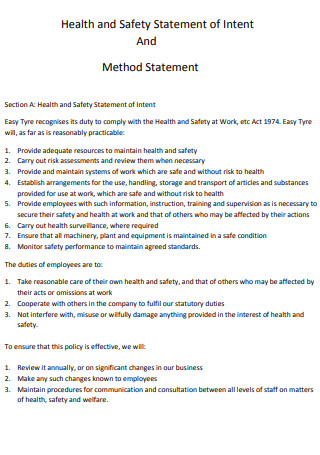
Health and Safety Statement of Intent And Method Statement
download now -
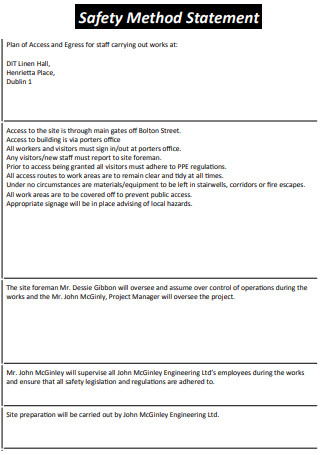
Standard Safety Method Statement
download now -

Health And Safety Site Specific Risk Assessment Method Statement
download now
FREE Health And Safety Method Statement s to Download
9+ SAMPLE Health And Safety Method Statement
What Is a Method Statement?
Benefits of Method Statements
Tips for Obtaining Health and Safety at Work
How to Create a Method Statement
FAQs
What is a method statement example?
Who prepares the method statement?
What are high-risk work activities?
What Is a Method Statement?
A method statement is a kind of health and safety record usually used for high-risk work. It tells workers the steps they need to take to do a job safely. They are primarily for the people working, usually those in the construction industry. The document should list possible dangers during a specific task and workers’ steps to keep themselves safe. The statement must be as transparent as possible so that it can’t be misunderstood in a way that could hurt someone. Everyone doing the work should read it to know what is expected of them and what safety measures are in place. Method statements can be helpful for more than just the people doing the work. Clients often need the documents during the bid process, especially in construction. This lets a company learn more about an organization and decide if they want to work with them on a project as a business partner. A thorough method statement will show that your company cares about safety and can provide a good service. Statistics show that about 10% of workers in the European Union are in the health and safety sector, and many work in hospitals.
Benefits of Method Statements
Why do organizations develop method statements and risk assessments? What are their purposes? The purpose of these documents, sometimes known as RAMS, is not limited to meeting legal obligations. Yes, but they can also produce a healthier and safer workplace with numerous business advantages. Risk assessments and method statements assist in the following:
Tips for Obtaining Health and Safety at Work
All employees should actively support the organization’s safety program to ensure the crew’s safety and workers’ safe return to their homes each day. If there’s one thing this pandemic has taught us, workplace safety is of the utmost importance and needs a seat at the table. All employees can contribute to creating a safer work environment by adhering to specific safety guidelines. Even though the following tips are not the only ones available, they show essential principles that lead to a safer work environment:
1. Always report dangerous situations
Workers are sometimes hesitant to report specific harmful circumstances and risks to their supervisors for fear of getting themselves or others in trouble. This is not conducive to a safe workplace since it may raise the likelihood of an accident or injury occurring on the job site. To aid in protecting themselves and their coworkers, all employees must quickly report harmful conditions. Once a hazard or risk has been discovered, the proper protocol must be followed to inform important participants so that risks can be mitigated swiftly and effectively.
2. Maintain a clean workspace
Avoid placing excessive objects near or on employees’ workstations. Additionally, they must never forget to wipe up any spills at their workstations and disinfect the area if it is shared with other employees. According to the EHS Daily Advisor article OSHA’s Fatal Four – Leading Causes of Fatalities in the Workplace, falls account for 36.5% of all workplace deaths. Slips, trips, and falls cause several accidents in the workplace each year, so encourage staff to take this OSHA compliance safety tip seriously.
3. Wear protective equipment
It is essential to urge workers to constantly wear the proper personal protective equipment, even though this may seem apparent (PPE). Workers frequently forget or choose not to use safety equipment such as goggles or hard hats because they believe it is excessive or they can complete the task more quickly without it. Personal protective equipment is allocated to keep workers safe and prevent injury or disease; therefore, constantly remind them to use the appropriate PPE for the task.
4. Take breaks
Tired and overworked employees are a liability at the workplace. Before accomplishing specific duties, employees must take breaks to recover and reenergize. Tired team members may constitute a threat since they cannot concentrate fully on the task at hand, resulting in an incident or mishap that could injure them or others.
5. Don’t skip steps and Keep up with new protocols
Occasionally, workers may be in a hurry to complete a task. Thus they may skip steps to achieve it more quickly. In addition, they may not use special equipment or tools efficiently to do the job swiftly. This must be avoided under all circumstances. Remind team members that procedures and workflows have been carefully designed to eliminate risk, so the safest action is to adhere to them. Also, new methods, protocols, or even equipment may be implemented in the workplace, ensuring that all employees are aware of and up-to-date on these changes. Workers must be provided with the proper training and education to comprehend what must be done to prevent a potential incident. Foster a culture of support and encourage employees to ask questions and communicate with their supervisor if they require additional assistance.
6. Maintain correct posture
It is essential to perform occupational duties with good posture. It is easy to overlook this safety precaution when you are engaged in a task, such as moving large goods or sitting at a computer. Employees must maintain correct posture to avoid aches, pains, and potential long-term damage to their neck, back, and shoulders.
7. Assist new staff
Seasoned and seasoned team members should always provide direction to less-experienced team members. It is necessary to educate them on the organization’s safety culture and the standards it follows to maintain a solid safety foundation. Suppose all team members are fully invested in the value of safety to the organization and themselves. In that case, they can work together to establish a safer workplace and a more robust safety culture. Remind employees to constantly keep these work safety tips in mind, from reporting harmful conditions to taking breaks, to ensure that everyone returns home safely at the end of the day. The staff can take daily actions like these to reinforce the importance of safety and the rewards it can provide.
How to Create a Method Statement
Method statements are essential because they outline precisely how to apply safety measures and assist teams in eliminating job-related risks. This is especially crucial in construction when projects entail high-risk aspects such as dangerous equipment, hazardous materials, or heights. Method statements are critical for limiting hazards and safeguarding site visitors, construction employees, and project managers. If you are prepared to create your method statement, the following steps will help you get started:
Step 1: Perform a risk assessment
Before creating your method statement, you must identify the hazards associated with your project’s tasks. This can be accomplished by doing a risk assessment. Document anything that could cause bodily harm, adverse health impacts, or pose a threat to others on the premises. Evaluate existing safeguards to determine if they adequately decrease risks to an acceptable level. Identify any extra measures required to reduce the possibility of harm further.
Step 2: Provide relevant company information and list hazards safety responses
Consider including all pertinent firm and employment information in your method statement’s heading. Additionally, describe any PPE, environmental, and quality control measures at the beginning of your method statement. List the steps team members can take to mitigate risks and ensure the safe execution of tasks. If the project involves additional actions from team members, such as waste disposal, hazard removal, or site cleanup, make sure to include those as well.
Step 3: Create procedure-specific instructions
In the final portion of your method statement, specify the guidelines construction team members must adhere to when executing their tasks. List your stages in a logical order and add any information your team will need to complete the project objectives safely and efficiently. Try to write so that it is accessible to all readers and that the safety rules and standards are simple for specialists to comprehend.
Step 4: Rewrite descriptions of new locations, equipment, and directives
Review your method statement if your project undergoes any modifications. Construction employment is frequently unstable. Even though you perform identical duties, the risks, conditions, and site needs can vary from project to project. Examining and revising your method statement allows you to account for every project component. New locations, teams, and equipment can all impact your established policies. Changes to reporting structures, cleanup procedures and project phases should also be reflected in your updated method statement.
FAQs
What is a method statement example?
Instead of repeating the information previously contained in a risk assessment, a method statement expands on the knowledge acquired for the risk assessment. It plans the activity’s sequence in greater detail. For instance, the risk assessment may indicate that the task requires monitoring.
Who prepares the method statement?
Method statements should be drafted by a knowledgeable individual familiar with the specified process. They may need to be agreed upon by the client, the principal contractor, and the contractor.
What are high-risk work activities?
Working in the construction industry with a danger of more than two meters of falls is considered high risk. The construction of a communication tower. Destruction of a structural element that is load-bearing or otherwise integral to the structure’s physical integrity.
The selection and presentation of your safety and construction technique statement require careful consideration of various issues. Therefore, utilizing all web resources to facilitate your work is highly recommended. Doing this for the protection of everyone exceeds the definition of a noble job. What are you expecting? Use our templates immediately!
